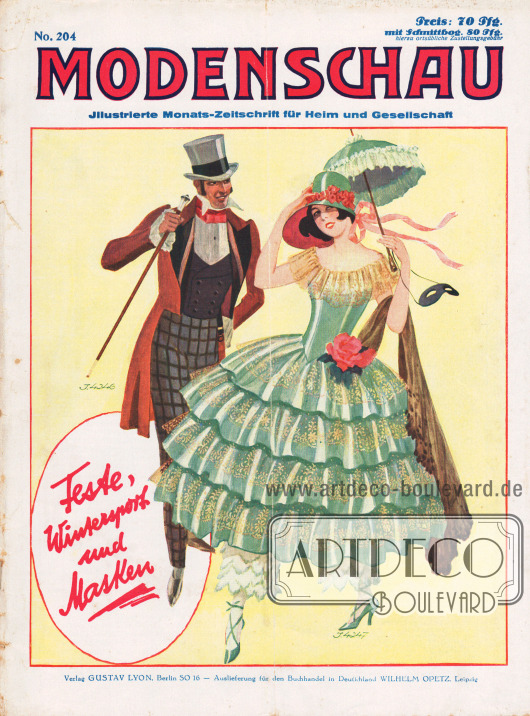|
|
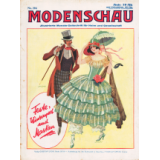
|
Title page or front cover of the German fashion magazine Modenschau (Eng. title: Fashion Show, subtitle: Illustrated Monthly Magazine for Home and Society) no. 204 for December 1929.
Festivals, winter sports and fancy dresses.
J 4246. Biedermeier gentleman's period costume, consisting of a rust-red tailcoat, checkered trousers, black vest and white shirtfront. Gray top hat. Fabric usage: about 2.25 m checkered, 2.85 m red, 1 m black, each 100 cm wide. Bust size 96 cm. Pattern price 1 mark.
J 4297. Ladies Biedermeier period costume made of turquoise taffeta, richly decorated with ocher lace. Tight bodice with a tapering extension at the front. Fabric usage: about 10.40 m, 90 cm wide; 19.40 m lace, 24 cm wide. Pattern size 44. Price 1 mark.
Price: 70 pf., with pattern sheet 80 pf., plus local delivery charge.
Publishing house GUSTAV LYON, Berlin SO 16 — Distribution for the book trade in Germany WILHELM OPETZ, Leipzig.
Title illustration/title drawing: unknown/unsigned.
|
|
|
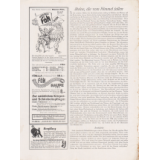
|
Article:
N. N., Stones That Fall from the Sky;
N. N., Anecdote.
[N. N., Stones That Fall from the Sky.]
In the second half of the 18th century, a meteor struck the earth in Siberia that was far larger than any that had been seen before. At that time, Catherine II was Empress of Russia. She commissioned the German naturalist Pallas to transport the enormous stone to St. Petersburg. There it was to be used for a monument to Peter the Great. It took Pallas two full years to transport the stone, which was carried on ball bearings. A meteor shower of even greater magnitude occurred on June 30, 1908 at 7 a.m., also in Russia, in the Yenisei province in the middle of the Siberian primeval forest. The impact occurred with a terrible roar that could be heard for miles and with enormous light and embers. It caused a large number of crater-like formations, many of which we know from the surface of the moon. The devastating effects of this eerie impact on the earth can still be seen today within a radius of 20 km. The mass of rock that fell is estimated at 50,000 tons. Astronomers believe that they can prove the exact origin of this unprecedented meteor shower on the basis of careful calculations. They claim that at the end of June 1908, the Earth was in close proximity to the comet Pons-Winnecke, and those meteors came from its tail. At the same time, a small stone weighing 4 pounds fell about 70 km from Kiev, and the day before, a fireball four times the brightness of the moon had been observed in Manchuria. No human lives were lost in that meteor shower. In contrast to a meteor shower that also occurred in Siberia at the beginning of November 1923, in which a two-story high building made of reinforced concrete was destroyed and eight people were killed. In general, meteors only come down to earth in small stones because they explode before they touch the earth's surface. The Earth is surrounded by an approximately 200-kilometer-high layer of air, called the atmosphere, which accompanies it on its orbit through space. It contains 4/5 nitrogen and 1/5 oxygen. Its main service for mankind and all living beings is that it provides us with oxygen, without which we could not live. But the atmosphere also fulfills a second very important task. It is — strange as it may sound — the armor of our planet and absorbs the catastrophic force of meteors, which, like fixed stars, planets and comets, hurtle through space and sometimes have enormous dimensions, when they hit the earth. The speed with which the meteor stones race through space is so tremendous that, overcome by the gravitational force of a planet, they are heated to white heat as a result of friction with the air. These enormously high temperatures probably cause gases inside the meteors to explode. The celestial colossus is blown apart and often hits the planet in thousands of small individual files. Such meteors can be seen particularly frequently in the sky on autumn nights. They are bright points of light that suddenly illuminate the darkness, describe a mostly straight-line path for a few seconds and then abruptly extinguish. Some meteors have a comet-like tail behind them. The brightness with which they light up is sometimes extraordinarily great. On December 3, 1861, a meteor suddenly appeared in the night sky as a ball of fire and spread a glow ten miles away that was far brighter than that of the full moon. Meteors differ from shooting stars, which can be observed on almost every clear autumn evening, in that the latter do not explode. They are the debris of celestial bodies that have been destroyed by some global catastrophe, such as the collision of two celestial bodies. They consist of the same materials as our earth. This means that all the celestial bodies in the universe are probably composed of the same materials. — On the night of November 14, 1928, a meteor 1½ cubic meters in size and weighing several hundredweights fell between two boathouses south of Godesberg. It burrowed into the bank of the Rhine.
[N. N., Anecdote.]
According to various traditions, Peter the Great seems to have attached great importance to having an educational influence on his people. He was all the more annoyed when he learned of the numerous thefts that were constantly being committed by his subjects. In order to discourage the thieves, he asked his chancellor to promulgate the following law: "Anyone who is caught stealing again, even if it is only a worthless object, will be hung without mercy." The chancellor laughed and said: "If Your Majesty wishes to be emperor without subjects, then I will promulgate the law." Peter the Great renounced the implementation of his idea.
Advertising:
New! Electric hand dryer Manu-Foen. ORIGINAL FOEN & SON. An old picture, everyone knows it: Knecht Ruprecht [or Servant Rupert, note by M. K.] at the head of his hair dryer regiment. This year, too, he will win the hearts of women and girls by hook or by crook. — Only genuine with embossed trademark FOEN.
Original Foen RM. 28.—.
Hairdryer Son " 21.—.
Luxury hairdryer " 32.—.
Hair dryer RM. 28.—.
Son hair dryer " 21.—.
Travel hairdryer " 36.—.
Almost a million in use! FOENELLA for the production and drying of water waves. Price RM. 6.—. FOEN RAUPE D.R.P. [German Reich Patent]. For ideal bed warming and for loosening the bed springs and bed care… Price RM. 8.—.
For natural body and beauty care:
Electric vibrators D. R. P.: Sanax vibrator, Penetrator (very strong), Vibrofix (light massage). Especially for obtaining slender restraints.
Electric high-frequency devices D. R. P.: Radiolux and Radiostat (floating).
Electric safety heating pads D. R. P.: Sanotherm and Sanotherm Son (with Vacu-regulator).
Available everywhere. We will donate an original hairdryer to the sender for every witty advertising idea we accept for printing. FACTORY: "SANITAS" BERLIN N 24. Drawing/illustration: signature "Silfus '29" or "Philfus '29" (difficult to read/unknown artist);
Corpulence is not only unattractive, but also annoying. The slightest exertion becomes torture for the fat person, impairing their enjoyment of life and performance. Become slim again in a medically recommended, harmless and healthy way. Drink Dr. Ernst Richter's Breakfast Herbal Tea. Dr. med. A. W. in Kr. writes: "I have lost 14 pounds without dieting and find this slow degreasing extremely pleasant". 1 package Mk. 2.—, cure = 6 packages Mk. 10.—. In pharmacies and drugstores, where not in stock "Hermes" Fabrik pharm. kosm. Praep. [factory of pharmaceutical cosmetic preparations] Munich S 70, Guellstr. 7.
|
|
P. 1 |
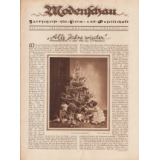
|
Title page or cover of the Modenschau (Eng. title: Fashion Show, subtitle: magazine for home and society) no. 204 for December 1929.
Article:
Wedekind, A. P., "Every Year Again"… Christmas Traditions Around the World by A. P. Wedekind (Anna Paula Wedekind-Pariselle, née Wedekind, 1890-1979).
In the center of the first page is a large Christmas tree festively decorated with tinsel, garlands, baubles and candles. In front of the tree on the carpet, a boy and a girl are playing with children's toys. The caption reads "'…the Christ child is coming'. Photo: Becker & Maass."
Photo: Atelier Becker & Maass, Berlin.
[Wedekind, A. P., "Every Year Again"… Christmas Traditions Around the World by A. P. Wedekind]
World trade, current affairs and not least fashion often blur the boundaries that separate peoples. Just as one meets the same types, the same angular skulls of money and industry princes on the stock exchanges of all countries, so also in the luxury hotels of the world the women of those upper classes resemble each other because they wear the same Parisian model creations, have the same interests in sport and bridge. Racial characteristics are leveled out by the all-dominant money, the ruler of our century. The middle class, on the other hand, although it has the same duties and concerns in all countries of the world today, is called upon to be the bearer of the true national spirit, the beautiful old customs and traditions of a country. They do not have the financial means of the upper classes, which would allow them to see the wonders of the world; they must be content and modest in their own homes. That is why, even in his meager free hours, he has the desire to embellish his everyday life and home. He does not dream of the magic of the great world — it is far too far removed from his simple nature and feelings for him to long for it. The romance of old customs lures him, conjures up the splendor of a rare celebration for a few hours in his narrow four walls. And it is typical of our time and the strength of the longing for this magic that the war has blurred the boundaries. Many a beautiful, old custom has now also become at home abroad, because the warm, quiet glimmer of the beauty of another world could transfigure hearts and people even in the most difficult of days. Many a dear, old, almost forgotten custom has been revived in our country because a comrade from another, distant part of the beloved fatherland planted it in the longing hearts of friends and fellow fighters. North and South, East and West found each other in the old, beautiful custom of nations, which can be a mediator of souls like no other. — Just now, as Christmas, the most beautiful festival of the year, is approaching, the customs and traditions that captivate young and old alike are revived and create better, more lasting values — because they touch people's innermost being — than money and monetary value. It starts with the first Sunday of Advent: happy are the families who hold on to the old traditions and place the little Christmas tree with the first light in the cozy, warm family living room on the first Sunday of the Christmas month! How the children's eyes are so attached to this first shining candlelight, which is a harbinger of all the Christmas joys to come! And the eyes of older children also shine brighter when they see the little tree. There is a festive atmosphere when a second candle is allowed to decorate the small, joy-giving tree on the second Sunday of the month. The silver and golden Sundays also become a celebration when the third and fourth lights are finally lit to the sound of Christmas carols, their glow proclaiming the good news: "Behold, it is Christmas!" The festival of love and joy on earth is approaching! Not everywhere is the little tree in the pot — of course already magnificently decorated with tinsel or candy — the herald of joyful tidings. Sometimes it is replaced by a fir-tree wrapped light holder, in some areas by the Advent wreath, festively decorated with silver ribbons and baubles, hanging from the crown or hung in the doorway between two rooms. The old, beloved Christmas carols, which conjure up a piece of childhood poetry for even the demurest, matter-of-fact everyday person, ring so joyfully once again in the glow of the Advent lights. Are they not also a good, old custom, … (continued on page 9).
[Page] 1
|
|
P. 2 |
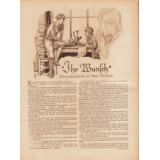
|
Article:
Bernhard, Marie, "Your Wish". Christmas Story (by Marie Bernhard, 1852-1937).
The drawing above shows a boy of about 12 years talking animatedly to a younger girl. He is sitting on a table while the girl seems to be willing to write something. On the table are a small globe and cacti. Behind them is a large window. On the right is the shadowy outline of a woman who seems to be observing the scene. Drawing/illustration: "k" (Ernst Ludwig Kretschmann (1897-1941).
[Page] 2
|
|
P. 3 |
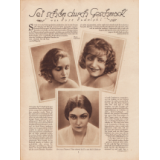
|
Article:
Rudolphi, Rose, Be Beautiful through Taste (by Rose Rudolphi, unknown author).
The three photographs accompanying the article show three different views in three different presentations of one and the same woman. The caption reads "Three new movie stars? No, three times the dancer Molly Ordeyner [biographical data unknown]. Photos: Federmeyer". Photos: Photographer, B. Federmeyer (biographical data unknown).
[Rudolphi, Rose, Be Beautiful through Taste.]
As far back as we look in cultural history, the desire to look young and beautiful has played an important role for women of all ages. They have never failed to devote time and effort to achieving this ideal. Incidentally, men have never done otherwise; they have just not had the honesty to admit to this quality. Both sexes have always rightly endeavored to create a favorable impression, because the sight of pretty people is always pleasing. For women, the cultivation of gracefulness was the prerequisite for an advantageous appearance, which for a long time was regarded as the only goal of female aspirations. Today, this is no longer necessarily the case, especially since even many women who are quite eager to marry no longer intend to provide for themselves through marriage. However, because the woman of our time has been drawn into the difficult economic struggle, because a life secured by pensions is only possible in very rare cases, even more attention must be paid to outward appearance than in the past. It is undoubtedly true that the majority of people judge by first impressions and attach decisive value to them. If the impression is favorable, it is much easier to establish business or private relationships. However, only a very small fraction of all living people can be considered beautiful, and there is also the strange fact that natural beauty is very often not effective because it appears external. On the other hand, it cannot be denied that we meet many people in life who are characterized by an appearance above the average, and who nevertheless never come into their own. They appear unfavorable because they are not clear about their impression and do not know how to draw attention to their advantages or cover up small imperfections. Be beautiful — through taste … is therefore an absolute necessity of our time. This includes one thing above all else: recognizing what advantages you have or how small imperfections can be remedied. Although we have come a long way in cosmetic surgery today, not everyone will want to hand themselves over to the knife for correction. Above all, the mirror must serve as an incorruptible friend, if you will. The rehearsal […] long and thoughtfully, just as only in front of it […] means are discovered which are to enhance the general impression. As much as the figure as a whole speaks, it is primarily the face that determines the person and by which he… (continued on page 43).
[Page] 3
|
|
P. 4 |
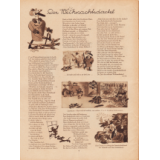
|
Article:
Malkowsky, Emil Ferdinand, The Christmas Dachshund (by Emil Ferdinand Malkowsky, 1880-1967).
Drawings/illustrations: Hans Ewald Kossatz (1901-1985).
[Page] 4
|
|
P. 5 |
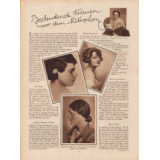
|
Article:
F., A. J., Prominent Women in Front of the Microphone (by A. J. F., unknown author).
The article is accompanied by four photographs. Only three photographs are labeled. The picture at the top right possibly shows Ola Alsen. The caption reads "Top left: Julia Kerr [1898-1965]. Top right: Elsa Kochhann [biographical data unknown]. Below: Lucie Mannheim [1899-1976]." (Photos: Jacobi, Schneider, Boehm.) Photos: Photo studio Jacobi, Berlin (Ruth Jacobi, 1899-1995, and Lotte Jacobi, 1896-1990); photo studio Ernst Schneider, Berlin (1881-1959); photographer Arthur Boehm, Cologne (1883-1934).
[F., A. J., Prominent Women in Front of the Microphone.]
In just a few years, a sensation in the field of technology has turned radio into a world power of enormous influence. In Germany alone, three million people listen to its broadcasts. For just two marks a month, the world is open to this gigantic audience. They can experience great historical moments, such as the Zeppelin's chase across continents or the conclusion of vital political conferences. Radio listeners can feel a breath of important events that would otherwise never have reached them in their bourgeois seclusion.
The woman is an eager and successful collaborator in this spiritual education of our people. She enriched and deepened the program by dealing with topics that particularly corresponded to the emotional world of the female soul. — In the following, some of the most popular female radio presenters describe their personal impressions they received when they occasionally spoke through the microphone to hundreds of thousands who remained invisible to them.
Ola Alsen [1880-1956], the popular writer who portrayed contemporary characters in perfect sculpture in her novels, also often spoke to us as a modern person through the mouth of the microphone. She writes: "I like to speak in front of the microphone. The printed word, which easily becomes impersonal through the cooperation of machines, is given life and vitality when spoken. Contact is created from person to person, from speaker to listener. It is probably only a matter of time before the listener can also see the speaker by means of video radio." Charlotte Muehsam-Werther [1870-1941], a member of the Reich Economic Council, was particularly predestined to speak on behalf of women as a member of the board of the Central Housewives' Association of Greater Berlin: "During my first radio lecture, I initially had to overcome a certain inhibition when I found myself facing the microphone instead of the usual audience. I overcame this inhibition by imagining an audience behind the microphone. Later I only felt the great joy of being able to shout out what was on my mind to an incalculable number of listeners."
Else Straka-Jansen [?-1943], the representative of the fine humorous genre, gives her impressions in the following verses: "When I appeared at the microphone — for the first time it was in Berlin — I felt familiar to him in an instant; I spoke and laughed and nodded to him as if the white thing were truly a crowd of listeners ready to laugh. Wherever I spoke in the German Empire, I felt just as comfortable. — But I must honestly confess that I was too silent at the end: "I like to hear the applause when my lecture is over! — —"
Gertrud van Eyseren [1896-1977], the universal linguistic genius for whom radio became her sphere of activity, chats inspiringly: "The daily half hour before the microphone culmination point of the day. No actual microphone fever, but a certain tension right up to the minute I sit in front of the little block of marble, which for me is the ear of the world. Because: the effect of the microphone: tremendously invigorating, exciting, intoxicating. What the audience and the theater atmosphere are to the actor, the microphone and the whole, wide world behind it is to me, to which I can speak. The happiness of life. (Words, voice, laughter.) A feeling of all-connectedness. But: after 23 minutes, the presenter announces the end of the broadcast again and again, the wide world and all feelings of happiness vanish, Potsdamer Strasse, bus 1, again one of many."
Henny Porten [1890-1960], the popular film actress: "When I sat in front of the microphone for the first time three years ago, I was really excited. I was told that my voice sounded as if I were an old man with a huge full beard. I myself felt as if my larynx had slipped and as if all the listeners could hear my heart palpitations more than my voice.
The next time it was better, and the last time I spoke into the microphone at the premiere of my film "Mutterliebe" ["A Mother's Love"], I was completely free… (continued on page 50).
[Page] 5
|
|
P. 6 |
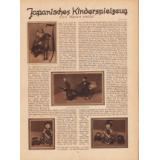
|
Article:
Hecht, Robert, Japanese Children's Toys (by Dr. Robert Hecht, unknown author).
The article is accompanied by four photographic illustrations. Three pictures have the caption "Japanese dolls with rickshaw" and "Left and right the same doll — and yet: how different — only by changing wigs! (Photos: Delia)." Photos: Delia (unknown photographer or agency).
[Hecht, Robert, Japanese Children's Toys.]
Japan is the land of children, the paradise of the immature. Nowhere else in the world are children treated with the same kindness and love. It is an inconceivable thought for the Japanese that a child could be beaten for being naughty, but Japanese children are not naughty in our sense either. For throughout the Far East, the first commandment is that children must sacrifice themselves for their parents under all circumstances. This doctrine is preached insistently to the little ones from an early age, so that even adults know no other duty than to serve their parents and to make any and every sacrifice for them. Nothing else is possible given the general attitude of the entire public. A Japanese who failed to take proper care of his elderly parents would be universally despised and would have to leave the country because everyone would shun him. The social character of the country is determined by the fact that family life is equally developed in all sections of the population. However, as long as the children are not yet able to feed themselves, they are cared for and provided for in every way. As everywhere else, the vast majority of the population is poor — but nowhere in Japan do you see dirty children, even the offspring of beggars wear clean clothes. However, living in Japanese style makes education easier. Apart from cushions, mats, a chest for clothes and a box for crockery, there are no household items in the homes. Children can't smash or knock anything over, and as almost all families live in their own tiny houses, they can make as much noise as they like. Another peculiarity of Japanese life is that it is not customary to celebrate birthdays, probably due to the fact that, until the introduction of European administrative customs, birthdays were not officially or ecclesiastically celebrated, so that mistakes could easily arise. On the other hand, Japan has two major children's holidays which are celebrated by the whole nation. The third of March is Girls' Day and the fifth of May is Boys' Day. The whole country celebrates these days, and the children look forward to them long in advance, as they are the days on which they receive plenty of presents. Only in wealthy families is it also customary to give presents on other days of the year. On the third of March, however, every doll store is colorfully decorated with "O Hina Sama", as the toys are called there. There we see Japanese life in miniature before us. The shamurai [or samurai, note by M. K.], the old Japanese knights in their armor on horseback, Japanese ladies being pulled by a rickshaw, farmers with broad hats and raincoats made of rice straw, fishermen with their nets, street singers, stilt walkers, adults, children, dogs, cats, birds, in short, everything that Japanese children see during the day is also reflected in their toys. The most popular dolls for girls are those called "Cha-no-ya", which come with several wigs, four to six pieces and more. By changing wigs, the playing child can change not only the appearance but also the character of her doll. All it takes is a flick of the wrist and the elegant lady has changed into a child, a geisha or a country woman. It must be said that Japanese women differ from each other in their hairstyles. The daily garment, unless it has already given way to European costume, the kimono, is made of cotton and is always dark grey or black in color. Only rich families wear silk kimonos, everyone else only wears them on festive days. Silk robes are passed down from generation to generation, and dresses that are more than a hundred years old are worn by noble families on important festive days. The colorful kimonos with the back bow are only worn by geishas, and those very colorful kimonos are also made for export, which are advertised as splendid pieces in Japanese stores in Europe and which no woman would wear in the Far East. The "Hing Matsuri", the girls' doll festival, is celebrated with particularly good food. There are bean cakes and sweet rice lemonade. Even more impressive, however, is the boys' festival on the fifth of May, known as "Tango-no-Sekku". Then the streets are flagged and a general wave of joy sweeps across the country. Giant paper carp flutter over the rooftops and fish-shaped lanterns are lit as night falls. The carp is seen by the Japanese as a symbol of courage and strength because it swims against the current, and the boys are given a reminder to be just as powerful and fearless in the face of all obstacles in later life. Their toys are predominantly warlike in character, which is not surprising in an aggressive nation such as the Japanese. Bows and arrows are still boys' toys. In… [continued on page 52].
[Page] 6
|
|
P. 7 |
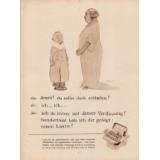
|
Advertising:
Full-page advertisement.
She: Armin! You're supposed to be asleep!
He: I… I…
She: Oh, you and your digestion! I've told you a hundred times to take Laxin!
Laxin is an exceptionally mild and safe laxative with a pleasant taste. — Recommended by doctors for sluggish bowels and poor digestion. Available in all pharmacies and drugstores.
Drawing/illustration: "KISSNER" (John Kissner (?), biographical data unknown).
[Page] 7
|
|
P. 8 |
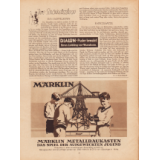
|
Article:
Hirsch-Matzdorff, Dr. A., Your Beauty Care (The Double Chin, Bath Additives) (by Dr. med. Alice Hirsch-Matzdorff, unknown author).
[Hirsch-Matzdorff, Dr. A., Your Beauty Care.]
THE DOUBLE CHIN.
The double chin is extremely unattractive. It makes a narrow face appear wider, robs the curved line of the neck of its beauty and makes you look older. That is why women want to get rid of it. In young people, the double chin is usually an accumulation of fatty tissue, as is the case in other parts of the body. This is where effective massage can help. Mind you, it helps, which means that an improvement can be achieved, but never a complete disappearance. Of course, vibration massage with various devices is quite pleasant, but the same can be achieved by hand. You can massage yourself, preferably in the morning and evening, starting with approx. 2 minutes, the duration can gradually be extended to 4 minutes, hardly any longer, as hands and arms tire easily. — Here are a few exercises: Place the thumbs of both hands on the bony prominences behind the earlobes and let the fingertips touch in front of the chin. Then stroke with the outside of the index fingers from the arch of the chin downwards to above the Adam's apple, keeping the thumbs firmly in place as a point of support. Place your left hand on your lower jaw with the back of your hand facing upwards so that your fingertips reach your right ear. Now stroke the back of your hand up to your left ear. Here the hand is turned around so that the back of the hand is now facing downwards and the stroke can be made with the palm of the hand in the opposite direction. You can do the same exercise with the right hand. Light tapping should be inserted between the strokes as a change. These are just a few examples that can be varied individually. It is best to powder the hands with talcum powder for the massage. Long patience and perseverance will ensure a certain degree of success. This is not the case with double chins, which occur as a result of sagging skin with increasing age. Here, of course, massage does not help at all. Only surgical cosmetic surgery is an option. Of course, this can also be used in the former case. However, it is still an operation and, as long as other options are still available, it requires a certain amount of consideration.
BATH ADDITIVES.
There are two types of bath additives: those that have a pharmaceutical effect, such as Stassfurt salt, and those that are used for beauty and luxury. Only the latter are of interest here. There are bath salts, pastilles, crystals, etc., all very different in shape, color, fragrance, composition and, depending on the price, to suit a wide variety of tastes. Some color the water and are also pleasing to the eye. The additives always spread a more or less pleasant fragrance that fills the water and the room and also clings to the skin. A large part of their refreshing, invigorating effect is based on this. However, many bath additives also have the purpose of softening the water, which is not only pleasant to the touch but also very beneficial for the skin. These ingredients also include those that are cheap and easy to make yourself, but which nobody knows as such, e.g. lemon. You need 2 pieces for a full bath. A few hours before the bath, the whole fruit, including the peel, is cut into slices in order to utilize the lemon oil it contains and placed in a bowl of water. Here the juices are extracted and the entire contents of the container are added to the bath water. Borax also has the property of softening the water. Chamomile tea is also pleasant as a bath additive — the so-called bath chamomile is then used. It has more of a calming effect, as is probably already known from its other applications. Dr. A. Hirsch-Matzdorff.
Advertising:
DIALON powder protects your darling from soreness.
MAERKLIN. MAERKLIN METAL CONSTRUCTION SET. THE GAME OF BRIGHT YOUNGSTERS. Brochures available in all relevant stores. Sources of supply can be obtained from Gebr. Maerklin & Cie G.m.b.H. Goeppingen 6 Wuerttbg. Drawing/illustration: Eugen Prinz-Schulte (1902-1981).
[Page] 8
|



